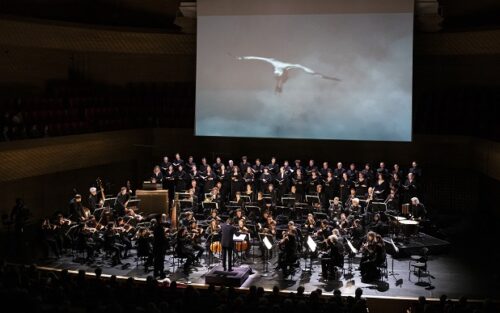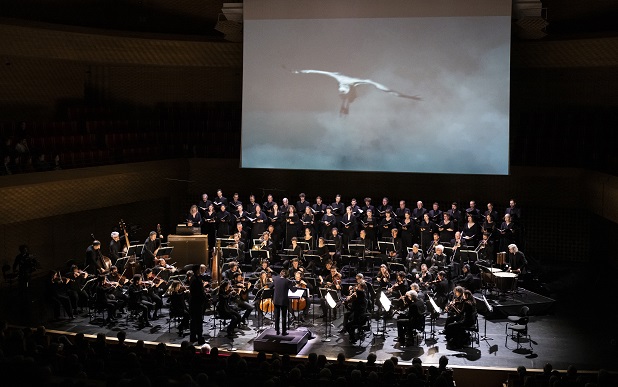 France Gounod, Fauré, SKY BURIAL: Child from the Maîtrise des Hauts-de-Seine (treble), Amital Pati (tenor), Samuel Hasselhoen (baritone), accentus, Insula Orchestra / Laurence Equilbey (conductor), Mat Collishaw (video). Patrick Devedjian Auditorium, La Seine Musicale, Paris, France, 15.2.2023. (CC)
France Gounod, Fauré, SKY BURIAL: Child from the Maîtrise des Hauts-de-Seine (treble), Amital Pati (tenor), Samuel Hasselhoen (baritone), accentus, Insula Orchestra / Laurence Equilbey (conductor), Mat Collishaw (video). Patrick Devedjian Auditorium, La Seine Musicale, Paris, France, 15.2.2023. (CC)

Gounod – Saint François d’Assise
Fauré – Requiem
The first question is surely, ‘What is a Sky Burial’? Click here and this video explains, and shows, the process; and it comes with the on-screen warning: ‘This video probably makes you feel uncomfortable, but this is our culture, hope you understand’. The YouTube video is not an easy watch for anyone squeamish as a corpse is carried to a place where it will be eaten by vultures. But it is practical: the area‘s ground is too hard for interment, and there are not enough natural resources for cremation.
The performance of Fauré’s Requiem was twinned with Mat Collishaw’s film, Sky Burial (An Interment in the Sky). Preceding that, Gounod’s Saint François d’Assise, a piece written in 1891 but only rediscovered a century later in a convent at Auvers-sur-Oise – in a nun’s cupboard! The manuscript was to be sold at Sotheby’s, but everything was done to keep in the French National Library (Bibliothèue nationale de France). Laurence Equilbey told me that it is the simplicity of the piece that impresses her, ‘the successful evocation of a language inspired by Gregorian modes,’ and that it exudes an ‘impression of happiness in simplicity and abandonment’. And, as Equilbey points out, in Gounod, ‘one can always note a harmonic refinement, an incomparable melodic vein, and a savant orchestration’.
Equilbey recorded this piece with accentus, the Orchestre de chambre de Paris on the Naïve label, where the soloists were the excellent Florian Sempey and Stanislas de Barbeyrac. There are two parts: ‘La cellule’ and ‘La mort’. At La Seine Musicale, tenor Amitai Mati was superb in the opening section, with Insula delivering Gounod’s harmonies absolutely radiantly, offering an aura of spirituality.
Against this performance was projected a stream of images of clouds, moving from dense to penetrating light as the music becomes ever more aspirational. A fine organ and the use of spatial separation gave the performance a sense of real depth. Hasselhorn’s statement of ‘Viens’ (Come – into my arms) was stunning, more effective even than de Barbeyrac in the recording. Equilbey traced every contour of the music, finding every nuance in Gounod’s beautiful web of orchestral colours. Her way with Gounod’s melody, too, is entirely natural, the upwardly moving trajectory of many phrases positively aspirational, while complementary, sighing, phrase endings seemed supplicatory to the glory of a Christian God.
While the recording was on modern instruments, here we have a period performance, adding extra layers of timbral variety and transparency. The Fauré, too, is the first time with Insula, which means brass ‘have a more contrasting colour, especially at forte,’ as Equilbey explains. Certainly, those individualities of timbre meant that the transcendent final passages of the Gounod were sublime; Collishaw’s images complemented the music superbly, but it was in the Fauré that we reached the truly sublime via the decidedly uncomfortable.
Colllishaw was originally approached by the conductor Teodor Currentzis (‘a very interesting guy’ who said, ‘I want you to do the requiem, but it should be different’). Collishaw‘s wife suggested the process of a sky burial, and the ‘contrast with the sanitisation of death in the West’ with ‘everything going on below the surface’. But ‘by relocating that to an urban tower block, the brutality the sky burial itself will really engage people. It will make the sublime elements a lot sweeter,’ Collishaw told me, and at the end the bodies of the dead ascend to Heaven in the bellies of vultures, as against the arms of angels. Collishaw learned the score via the Herreweghe recording before searching for appropriate images for the film. It took around 18 months to work out the outline, then came the technicalities (drone? CGI?). The death scenes were filmed in Collishaw’s studio, and the of course there are the vulture handlers and the CGI staircase for the ascent to the rooftop at the end.

The effect of the film on our perception of the Fauré Requiem – a piece almost achingly, cosily, familiar – was remarkable. Normally considered one of the ‘softer’ requiems (compared with Verdi’s gargantuan effort!), this event added whole new layers. As Equilbey says, the use of original instruments, with their more individual timbres and increased rawness of sounds, works supremely well, especially when combined with the uncompromising nature of Collishaw’s imagery. We see the sheer beauty of a vulture in flight – a terrible beauty, as we know these are scavengers who will dismember a corpse mercilessly. But, just as death is a natural part of life, so the vulture’s methods of survival are entirely natural, and not in any way cruel. It is our reactions that make them such, our emotional reactions grafted onto the act itself. The audience’s reaction to death itself is tested here., too. And not just in that final, bloody dénouement (although it could, in fairness, be a lot bloodier), but in the repeated death scenes – people immediately deceased, with family and loved ones around them, a giving up of life on the one part, and the gift of witnessing a transition for the rest. A dystopian tower block is the setting, and just as vultures circle the dead, so a drone camera circles the building, zooming in on a window at a time and showing us what lies within.
Equilbey’s period instruments markedly affect one’s experience of a score, and that is particularly true here, not just in the raw drama of the opening bare octaves, but in the fragility of the textures (both orchestral and, for that matter, choral) of the ‘Offertoire‘. There, the archaic seems particularly clear in the single-note chant of the baritone’s ‘Hostias’, only truly expanding melodically at the line ‘Fac eas, Domine, de morte transire ad vitam’ (Allow, them, Lord, to pass from death to life) – a line so relevant to the death scenes on-screen.
Against this, Collishaw’s film juxtaposes the mundane with the transcendent – in one room we see that potent image of everyday mundanity, a carefully placed vacuum cleaner, a reminder of the world outside the room that continues; counterpoint in visual terms, perhaps. Incidental detail is carefully done: the ‘detritus of life, the mess that we make, the stains that we leave and the crap we leave behind as we depart,’ as Collishaw relates it. There is contrast, too, between the grungy tower block, a spatially restraining citadel of death within itself, and the beauty of that death: a fortress which contains the act (art?) of the transition of spirit itself. The image of a river recurs regularly in Collishaw’s film – yes, the beauty of nature, but also a sense of flow (the monodirectional nature of time – rivers don’t flow backwards), and also perhaps a return to source – for a river, it might be the sea, for a human it is whatever lies beyond the veil. Also, there is the idea of ‘paying the ferryman’ (Collishaw’s phrase) or of the psychopomp Charon, the ferryman of Hades. Other details are telling, not just emotionally but in the actual telling the story – a disconnected oxygen cylinder tells us of its uselessness in post-mortem space and time.
The death scenes are spectacularly well done, even, on one occasion, capturing a true sense of otherworldliness in the deceased’s eyes. All the more impressive given that Collishaw found his actors via a shout-out on Facebook! The innocence of the Pie Jesu seemed impossibly heightened by the use of a young boy treble – superb, incidentally, true of pitch and with a lung capacity that appeared to well exceed that implied by body size. The sudden warmth of the ‘Agnus Dei’ offered something of an oasis – and how supreme were the tenors of accentus (even more impressive than on the recording), and how the sopranos thinned their tone to a thread at the arrival of ‘Lux aeterna’ (Light eternal). The grandeur of the horns’ statement before the return of the opening ‘Requiem aeternam’ was simply unforgettable – and with it, on the screen, another soul’s departure.
Flights of stairs appear for the ‘Libera me’ – stairs that will enable the ascent to the rooftop and the ensuing feasting. There is the inevitable thought that these are spirits already in ascent, and that the bodies themselves at the rooftop are empty – and therefore fair game for food. Here is when the genius of this treatment really came in: the ‘Dies irae’ in Fauré’s Requiem is rarely experienced as truly frightening, yet here there were real frissons as we saw bodies (plural) on the roof in shreds. The tempo of Collishaw’s film changes markedly at this point. Up until then, one experienced long phrases – the film moves onwards slowly. Suddenly, now, there are cuts between shots every couple of seconds.
The concluding ‘In Paradisum’ found the sopranos of accentus in perfect accord in their long unison line – and how glorious the harmonic arrival at ‘Jerusalem’, perfectly paced by Equilbey. A vulture lies in the sky again, so perfect, so beautiful. It does not need to move its wings; instead, it glides, guided by divine/natural forces, just as it was at the feasting of human corpses.
Effectively, there are multiple voices at work here: Fauré’s vernacular, the Latin text of the Requiem Mass itself and the visual counterpoint of Collishaw’s film. The arc of the film is simple, but the ‘weaving’ of images is what gives the film its profundity.
A massively moving, profound experience, and a true melding of the heard (the Requiem) and the seen (Collishaw’s film). Cameras were present (a French TV channel has commissioned of film of the event) – relevant not only for the documentation but also because the lighting had to be brighter than was ideal, as Collishaw revealed, so that proper blacks came out as dark greys. The film for the Gounod was quickly prepared (but remains effective), while Sky Burial itself is the fruit of long work.
In May, Insula will perform La Nuit des Rois (with music by Robert Schumann) with a staging by Antonin Baudry and videos by Anatole Levilian Clément’; there is then a project in 2024 around Beethoven’s King Stephen and The Ruins of Athens transposed into the world of Manga and XR, with the director Antonin Baudry and Pierre Buffin’s BUF studio.
Colin Clarke
